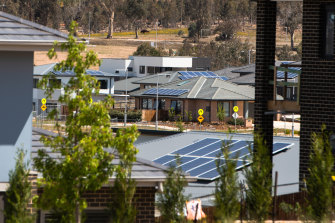Lending to highly-geared home buyers rose in the December quarter as the property market also rebounded, sparking debate over whether riskier lending is starting to re-emerge.
As regulators keep a close eye on the surge in house prices, figures from the Australian Prudential Regulation Authority (APRA) on Tuesday showed a rise in the proportion of new loans with high loan-to-valuation ratios (LVRs), and loans with high debt-to-income multiples.
Loans with high loan-to-value ratios increased in the December quarter, potentially due to first home buyers entering the market.Credit:Elesa Kurtz
Analysis by UBS economist George Tharenou found the share of new loans that were more than four times the borrower’s income rose from 57.7 per cent to 59.3 per cent, the highest level since the figures started in 2018. Mr Tharenou said loans with an LVR above 80 per cent also rose from 39.9 per cent to 42 per cent, the highest since 2008.
“We assess today’s data on home loans as showing a significant quarter-on-quarter increase in ‘higher risk’ home loans,” Mr Tharenou said.
Also on Tuesday, figures from the Australian Bureau of Statistics showed average capital city house prices rose 3 per cent in the December quarter, with Sydney prices up 3 per cent and Melbourne prices rising 3.4 per cent.
The trends come as the Reserve Bank of Australia is closely watching the mortgage market, amid concerns ultra-low interest rates and strong house price growth could lead to prices overheating. Separately, the Senate has been debating a federal government plan to roll back responsible lending laws, which critics say could increase risky lending. Consumer group Choice highlighted that the debate on the issue was deferred late on Tuesday.
Despite the focus on potential risks in bank lending, regulators on Tuesday signalled they were not yet overly concerned, as they remain focused on helping the economy recover from the massive shock of COVID-19.
APRA said the increase in higher LVR lending was probably a reflection of strong demand from first home buyers, while it said the lending at higher debt-to-income ratios was within its historical average.
“Despite moderately increased new lending at higher loan-to-valuation ratios and debt-to-income ratios, available indicators do not suggest any material relaxation in housing lending standards, with these metrics remaining broadly in line with historical averages,” APRA said.
The Reserve Bank’s latest board minutes, also published on Tuesday, made it clear the central bank has a close eye on property prices, but it viewed lending standards as “sound”.
‘We assess today’s data on home loans as showing a significant quarter-on-quarter increase in ‘higher risk’ home loans.′
Banks are still expected to face rising arrears this year, as industry and government assistance schemes end later this month. But the fallout from COVID-19 for banks has so far been less severe than feared, and on Tuesday the Australian Banking Association said 97 per cent of mortgages that were deferred had now returned to repayments.
With property prices forecast to keep climbing, some analysts have predicted banks may curb riskier lending later this year. One lender, ME Bank, this week tightened some credit standards for customers who were very highly-geared, saying it would decline customers wanting to borrow more than seven times their income. The bank said it had a positive outlook towards property and the changes were aimed at making sure customers could meet their repayments.
Market Recap
A concise wrap of the day on the markets, breaking business news and expert opinion delivered to your inbox each afternoon. Sign up here.
Most Viewed in Business
From our partners
Source: Read Full Article

